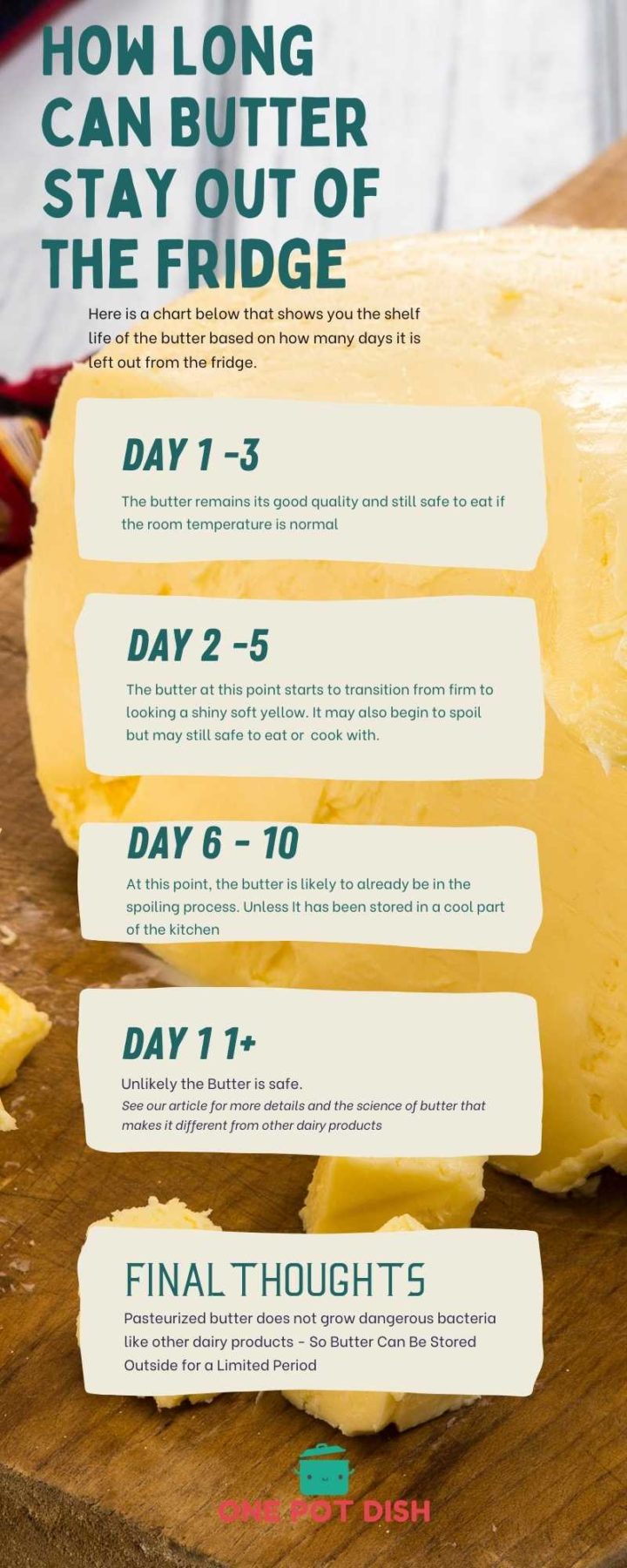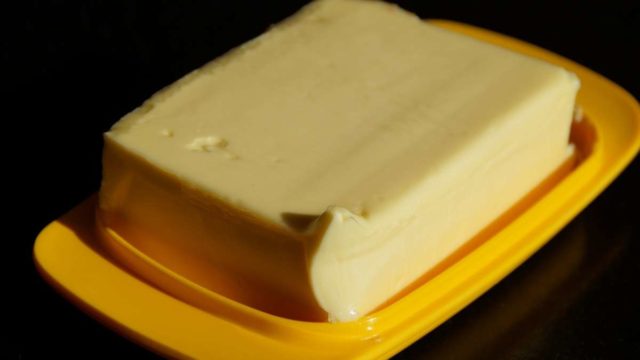How Long Will Butter Last Out Of The Fridge?
Butter is a staple dairy product in everyone’s kitchen. It is also one of the most commonly used cooking ingredients and is used in different dishes from your favorite breakfast pancakes to sautéing spices for the pasta. Because it is so commonly used it is easy to leave out of the cool store. Some people debate strongly about leaving the butter in the fridge or not.
But many folks in countries including America used to leave their butter in the fridge believing that it is a safer choice. There’s even a compartment in many refrigerators for storing butter alone. However, some people tend to leave their butter out at room temperature, which makes other people freak out.
In this article, let us learn how to properly store it for safety, better taste, and freshness. Keeping the butter out of the fridge depends on the type of butter (salted or unsalted butter), type of container used for storage (dish, plate, or sealed container), and the kitchen temperature.
Let us get into the basics first to learn more and then we can understand “Is it safe to leave out?”
What Is Butter And How Is It Made?
Butter is defined by Britannica as a dairy product, a yellow-to-white solid emulsion of a range fat globules, some water, and lots of inorganic salts produced by stirring and churning (separates the butterfat from the buttermilk) the cream from dairy milk.
It is classified into two main types: salted butter and unsalted butter. Salted butter contains added salt that serves as a preservative and flavor enhancer. Salt is a natural preservative – and I am sure you recall it being used to preserve meat, hams, and many products. Salted butter is commonly used as a spread or for melting over waffles and pancakes.
Unsalted butter contains no salt. It has a shorter shelf life and commonly used in baking.
The color of the butter depends on the carotene content and other fat-soluble pigments in the fat. Most of the butter in the United States is enhanced with vegetable color in order to improve the yellowness.

Other Food Safety articles are
- Humus – Can it Stay Outside overnight
- Pizza Dough – How Long Can it last at Room Temperature
- Is a Big Mac safe to eat overnight
Day 1 to 3:
The butter remains its good quality and still safe to eat.
Day 2 to 5:
The butter at this point starts to transition from firm to looking a shiny soft yellow. It may also begin to spoil but may still safe to eat or cook with.
Day 6 to 10:
At this point, the butter is likely to already be in the spoiling process. If stored in a cool, dry, and sealed container, it could still be safe to eat. However, it may have begun to turn into rancid butter so check carefully.
Day 11+:
If stored improperly, it will be spoiled butter by this time.
TIP: Do not use dairy that is past its best before date e.g expired butter
Not all containers are safe for storage.
If you want to keep your butter out on the counter or shelf, then get a sealed storage container like a butter crock, butter bell, or even a French Butter Keeper. These containers are actually for butter storage. Many people however opt for refrigerated butter.

If you do not have these a zip lock is also a good alternative.
Other Dairy products need to be kept cool – While whipped butter or unsalted butter should be kept in the back of the refrigerator to prevent it from spoiling. Also, raw milk and homemade butter (sometimes called raw butter) should always be kept in a fridge since they are all not pasteurized. Hence, bacteria can easily build up within the butter.
Cross-contamination – one of the big downsides of storing at room temperature is cross-contamination from a knife that has touched something like meat that has bacteria on it and they can then continue to divide and multiply quickly – so take care and always examine the butter carefully before use if it has been left at room temperature for long.
As mentioned previously, salted butter is the best type to be left out in the open, especially pasteurized ones. The salt in the butter helps in keeping the bacteria growing in the butter itself.
If you want soft and spreadable butter, keep it a room temperature and keep it covered. Make sure to replenish and clean the butter dish to avoid bacterial growth and cross-contamination.
People living in a cooler environment have better room temperature storage than those living in a hotter area. If the room temperature goes beyond 70°F, then it is best to put it back in the cool. While room temperature butter is easy to spread- there are also products that are easily spread straight from the refrigerator.
Cold butter if wrapped in an airtight container will keep a long time, you can also use plastic cling wrap, a freezer bag, or a well-sealed aluminum foil package.
How Can You Tell If the Butter is Bad or Spoiled
If you have not stored your soft butter properly, these things listed below may happen even before you knew it. Take note that you have to discard the softened butter if you happen to notice any (if not all) of these:
A butter’s edible color is white to yellow. However, if the whole stick turns out to become dark yellow instead of the usual pale yellow, then it is already in the process of discoloration. It can also undergo oxidation if the surface color is yellow and the inner surface is pale. Remove the oxidized part and you can consume the rest of it.
Molds appear in the butter if they are stored at a humid room temperature and if it has mixed leftover bits of food.
A spoiled food normally produces a rancid or sour smell. It can lead to food poisoning if eaten so watch for rancidity.

What About Margarine?
Margarine is a cheaper substitute for butter. Britannica defined it as a food product, which is made of vegetable or animal fats that are dispersed in an aqueous portion. It contains a lot of salt as flavoring ingredients, as well as milk products, yellow food pigments, preservatives, emulsifiers, butter, vitamin A, and vitamin D. Just like butter, it is commonly used in cooking and as a spread for bread.
Margarine is best when stored in the fridge since it has a higher tendency to separate the oil and produces a weird type of taste and texture. It has a longer shelf life than butter since it can last up to 5 months if left unopened in the refrigerator.
How to Soften Refrigerated Buttercream
If you have placed your buttercream frosting in the fridge and turns out to be overly chilled, you just simply have to take it out and place it a room temperature to slowly thaw it. However, frozen buttercreams might take longer to completely soften.
If it is stored in the freezer, you need to transfer it to the fridge or chiller for several days before using it. This step will allow the frosting to thaw gradually and prevent temperature shock, as well as cross-contamination.
How long does buttercream last?
When stored properly in the fridge, it can last for up to one month. If stored in the freezer, the shelf life can extend up to three months. Just like the butter, make sure it is store off from the air, placed in a sealed container, and chilled. If stored at room temperature, it can only last up to three days.
What is vegan butter?
Vegan butter is a dairy-free, plant-based butter. It is usually made of plant-derived oil, such as olive, avocado, coconut, palm kernel oil, or a combination of oils. It is similar to margarine since it has salt, emulsifiers, colorings, and natural or artificial flavor to make it look and taste the same as butter. What makes this apart from butter or margarine is it never has any ingredient from animals.
If you are on a diet or lactose intolerant, this is a convenient substitute since it has a similar effect in cooking and baking. This is also lower in saturated fat; hence it prevents from increasing the risk of heart disease and other chronic diseases.
Can you put the butter back in the fridge after softening?
Yes. Only if it is not stored for a long time outside the fridge. The best way is to place the butter out from the fridge within ten to fifteen minutes after using it.

The science behind why butter can last at room temperature longer than other dairy products like milk.
Almost all store-bought butter is Pasteurized – unless it is marked as RAW.
Pasteurized butter does not grow dangerous bacteria like other dairy products – or certainly not as quickly.
There is confusion about whether it’s safe to store butter on the counter? This most likely comes from the fact that most other dairy products are considered time-temperature control for safety (TCS) foods. This means that harmful Bacteria can multiply quickly, and when such foods are left at room temperature longer than four hours, they become unsafe to eat – even unsafe after cooking.
But pasteurized butter is a more stable product. A 2003 study undertaken by the FDA revealed that pasteurized butter does not grow bacteria like other common dairy items.
So what happens – well the pasteurization process reduces any pathogens initially found in the cream a constituent of butter, and the churning process immediately afterward alters the butter into a solid state. Also during the manufacturing process, the water molecules in butter become separated by the fat, which is hard for bacteria to penetrate. The result is this protects butter from pathogen growth. For this reason, butter can be stored safely on the counter for a number of days – see our detailed infographic chart above.